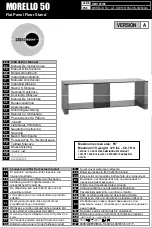
MSC..-1S..E
Supplement: MINI-SCREEN Models with Selectable Trip/Latch Output
P/N 68980
Banner Engineering Corp. • Minneapolis, MN U.S.A.
www.bannerengineering.com • Tel: 763.544.3164
Before the reset of the safeguard is performed, safe work procedures must ensure that a
start-up procedure is followed and that the operator verifies that the entire hazardous area is
clear of all personnel. If any areas can not be observed from the switch location, additional
supplemental safeguarding must be used to guard those areas. At a minimum, this should
consist of visual and audible warnings of machine start-up.
A reset switch that is key-actuated can give some level of personal or supervisory control by
removing the key and taking it into the guarded area. This will hinder a reset while the key is
under the control of one individual. However, this method must not be relied upon solely to
guard against unintended or inadvertent reset, because others may enter the safeguarded
area unnoticed, or additional keys may be in the possession of others.
Section 3. Addition
3.(s) Controller Module Configuration
Replace all references in Section 3.4 and Figure 18 of “Auto Power-up” with “Trip/Latch
Output Select.”
Replace the sub-paragraph titled “Auto Power-up Feature ON or OFF” with the following:
Trip/Latch Output Select (Auto/Manual Reset)
Locate the DIP switches to configure the receiver for Trip Output (Auto Reset) or Latch Output
(Manual Reset) as described by Figure 18. If Trip Output is selected, the FSD/SSD outputs
will turn ON as soon as power is applied, the unit passes an internal self-test/synchronization,
and recognizes that all beams are clear. The Trip Output will also automatically reset after
all interruptions of one or more beam(s) have been cleared. If Latch Output is selected, the
MINI-SCREEN requires a monitored manual reset at power-up and each time all interruptions
of one or more beam(s) have been cleared. Switch #2 must be set identically at both banks A
and B.
Regardless of the setting of this switch, a key reset is always necessary to recover from an
internal lockout condition.
See Sections 2.2(s), 2.10(s), and 3.2.1.1(s) for Warnings and further information.
Section 3..2 Replacement
3..2(s) External Device Monitoring and System Power
Temporary Connection
For the initial checkout procedure, the External Device Monitoring (EDM) must be temporarily
configured for “No Monitoring” (jumper TB2 Mon a and Mon b); refer to Figure 20(s) and
Section 2.8(s). This will allow the MINI-SCREEN System to be checked out as a stand-alone
system, before permanent connections are made to the guarded machine.
Verify that the power has been removed from the machine or that power is not available to
the machine controls or actuators. Also verify that the machine controls (MPCEs) are not
connected to the FSD and SSD outputs at this time. Permanent connections will be made
after MINI-SCREEN initial checkout; see Section 3.5.5(s).
Connection of System AC power (e.g. 115V ac) is at the L and the N terminals of control box
wiring barrier TB1. All wiring must comply with NEC and local wiring codes. Do not operate
the MINI-SCREEN System without a proper earth ground connection at either of the PE/GND
symbols.
WARNING . . .
Use of
MINI-SCREEN Systems for
Perimeter Guarding
If a MINI-SCREEN System is installed for
perimeter guarding, the system MUST
require actuation of a Reset switch before
initiating the dangerous machine motion
following an interruption of the defined
area.
If a MINI-SCREEN System is used for
perimeter guarding, the Machine Primary
Control Elements (MPCEs) of the guarded
machine must be wired so that the FSD
outputs of the control box cause a latched
response of the MPCEs. The MPCEs must
be reset only by actuation of a Reset switch.
The Reset switch must be located outside
of, and not be accessible from within, the
area of dangerous motion, and it must be
positioned so that the area of dangerous
motion may be observed by the switch
operator during the reset operation.
Additional safeguarding, as described by
the ANSI B11 series of safety requirements
or other appropriate standards, must be
used if any space between either defined
area and any danger point is large enough
to allow a person to stand undetected by the
MINI-SCREEN System. Failure to observe
this warning could result in serious bodily
injury or death.






























